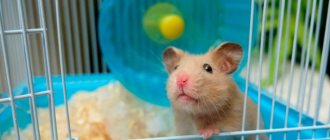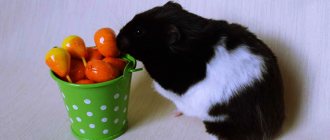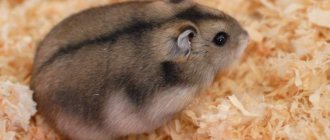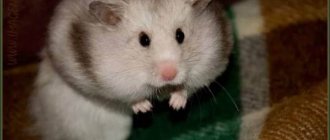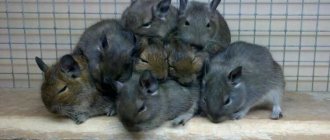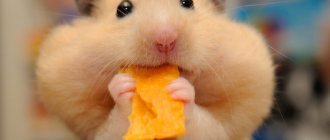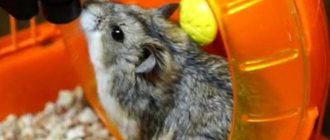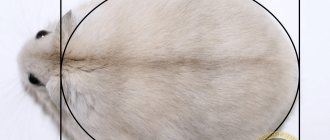Place plenty of hamster toys in the enclosure for entertainment. A wheel with a hard surface (rather than bars) is ideal to minimize the risk of injury.
Other options include tunnels and bridges for shelter and climbing, and wooden chewing blocks for dental hygiene. Additionally, add a nest or sleeping pad (pet stores usually have several options) in a corner of the enclosure.
Line the bottom of the enclosure with 5 cm of bedding. Products made from paper or aspen are recommended. Do not use cedar or pine bedding as the strong odor can be harmful to your hamster. Change it weekly and wash the enclosure with soap and water.
What to feed a Syrian
In the wild, the diet of hamsters includes cereals, fresh fruits, vegetables, berries and herbs, as well as food rich in proteins - worms, small insects, and sometimes mice.
At home, organizing your hamster's nutrition will not be a hassle.
The basis of the diet is grains. You can purchase cereal mixtures at a pet store. Special mixtures contain wheat, oats, corn, millet, sunflower seeds, peas, peanuts, buckwheat, peanuts, sesame and more. These products are necessary to replenish the necessary energy and maintain the health of the rodent.
Pay attention to the amount of nuts and seeds in the mixtures. The volume of these components should be minimal. Nuts and seeds contain large amounts of fat. Excessive consumption of this mixture contributes to an increase in fat mass, which will negatively affect the baby’s health.
You can prepare cereal food yourself. You can add pumpkin, watermelon and melon seeds to this mixture. The amount of ingredients can be adjusted depending on the pet's preferences.
Add fresh greens to your rodent's diet daily: plantain, burdock, green salad, dill, parsley, clover, knotweed, nettle (processed with boiling water), wheat germ, oats and other seeds.
You can add dandelion, wormwood and tarragon to the food with caution.
If you collect grass yourself, choose places far from the road, for example, in a summer cottage. Before letting your pet eat grass, rinse it thoroughly and dry it.
Fresh branches of fruit and deciduous trees are necessary for the rodent to grind down its constantly growing teeth. Hamsters can be given branches of the following trees: apple, maple, poplar, pear, cherry, ash, birch and some others.
Cut the twig in environmentally friendly places and treat the treat before feeding: rinse and remove twigs.
Hamsters enjoy eating nutrient-rich vegetables. It is recommended to feed rodents with carrots, cucumbers, pumpkin (without peel), sweet peppers, zucchini, radishes, turnips and beets. Choose foods carefully before feeding. Vegetables containing chemicals such as nitrates can negatively affect the health of hamsters. Pesticides, even in small quantities, can cause poisoning.
It is not recommended to add fruits with rotten areas to food. Vegetables must be peeled and cut into small pieces. Small slices will be more convenient for your pet to eat.
Sweet fruits contribute to weight gain, so hamsters should not eat them daily. The following fruits can serve as treats for your pet: apples, pears, bananas, peaches and apricots.
Remove seeds and seeds from the fruit, cut into small pieces, peel and feed to your pet in small portions.
In nature, hamsters feast on berries. You can feed strawberries, wild strawberries, raspberries or grapes. Choose ripe fruits and wash them thoroughly.
A small body also needs protein foods. The most useful sources of protein for a rodent are: chicken and quail eggs, boiled chicken breast, low-fat fish, low-fat cottage cheese, fresh green peas, chickpeas soaked in water, insects and worms.
Do not overuse protein foods. The recommended intake is 2-3 protein days per week. Alternate foods.
What to feed the animal
Juicy foods are not enough to maintain water balance in a rodent’s body. It is imperative to place a water bowl in the rodent's cage. It needs to be updated every day.
Benefit
The benefits of radishes are undeniable. It contains microelements such as phosphorus, calcium, magnesium, sodium, iron, natural fiber, B vitamins and vitamin C. The value of the product for the rodent’s body lies in its following properties:
- Thanks to the vitamin C it contains, it strengthens the immune system and helps the animal’s body fight colds. In the spring-autumn period, the root vegetable can be given as a prevention of vitamin deficiency.
- Be sure to pamper your pregnant female with this delicacy, because during pregnancy her body needs additional vitamins and minerals. For example, folic acid contributes to the proper intrauterine development of babies.
- Moderate consumption of the product has a positive effect on the functioning of the animal’s cardiovascular system.
- It has choleretic properties and effectively cleanses the liver.
- Normalizes metabolism.
- Improves blood circulation.
- Prevents the development of diabetes. This disease is common among hamsters.
- The root vegetable is rich in fiber. For animals suffering from constipation and bloating, the product is simply irreplaceable.
- It is useful for rodents with excess body weight, as it contains a minimal amount of calories, only 15 per 100 g. Improves metabolism and removes toxins.
- Pectin, which is part of the vegetable, helps cleanse the animal’s body of toxins.
- It is known that animals in old age often lose their appetite; mustard oil contained in the vegetable helps awaken the appetite.
With so many positive properties of radishes, the question arises: is it possible to give hamsters the root vegetable in large quantities? And how often? It turns out that it also has contraindications.
What not to give
Rodents are considered omnivores. But some foods cannot be given to hamsters. Feeding hamsters the following foods can cause health problems and even be fatal.
Syrian hamsters should not be given the following foods: fats of any origin, salt, sugar, chemical additives, spices, pine needles, plant bulbs, sour fruits, berries and plants, citrus fruits, cabbage, mint, garlic, most dairy products, berry and fruit seeds, mushrooms , potato sprouts and peels, baked goods, food for birds or other animals, canned food and smoked meats.
The above products should be completely excluded from the animal’s diet. Adequate nutrition is a very important element of a comfortable and long life for a hamster.
Where to buy a Syrian hamster
You can buy a Syrian hamster from a pet store, but it is better to go to a reputable breeder or shelter.
Good breeders usually provide excellent care for their animals, and they will give you extensive information about the animal's background and health history.
When choosing a hamster, it is best to observe the seller's animals while they are awake. The seller can also wake up his hamsters for you to choose one of them by offering the desired treat.
A healthy hamster will be active and inquisitive. His coat should look clean, his litter should be well formed, and his eyes should be clear and bright.
Appearance and features
Photo: Syrian hamster boy
Syrian or golden hamsters were bred in laboratory conditions from wild hamsters brought from Syria by zoologists in the last century. The body length of an adult is approximately 13-15 centimeters. Average body weight is 200-300 grams. This species is characterized by sexual dimorphism. Female individuals have a larger and stockier body. At the same time, the body length of females is slightly less than that of males. Another distinctive feature is the shape of the back. In females it is straight, in males it has a pointed shape. Individuals can also be recognized by the number of nipples. Females have four of them, males have only two.
Animals have a specific structure of their limbs. They have 4 toes on their forelimbs and five on their hind limbs. Most individuals of this species are golden in color, but individuals of other colors may occur.
What colors of Syrian hamsters can be found:
- copper;
- chocolate colors;
- sable;
- beige;
- honey;
- dark chocolate color.
The color may be uniform or have spots of a different color. The body of Central Asian hamsters is covered with thick and soft hair. Golden hamsters come in long-haired and short-haired varieties. The hamster's muzzle has a round, slightly elongated shape. There are small, rounded ears on the side of the head. The hamster's eyes are large, round, black, shiny. The nasal part of the animals is framed by whiskers. Hamsters have a small, short tail that is almost invisible in their thick fur.
Fruits for your hamster
Hamsters can be given various fruits (with the exception of citrus and exotic ones), but in small doses. The high sugar content makes this complementary food unsafe. Domestic Djungarians are given less of it than individuals of the Syrian breed - within 5% of the main diet. Campbell's hamsters are fed even more carefully.
The main fruit products that are suitable for Syrian and Djungarian hamsters include:
- apple - choose sweet and sour varieties, introduce them from 4 months, do not give to lactating females;
- apricot – a little and not overripe, it is better to give dried apricots out of season;
- peach is better than nectarine, it has less sugar;
- pear – firm yellow or green, uncommon;
- banana – preferably a little greenish, just unripe;
- plum - a little at a time, so as not to provoke diarrhea;
- melon – due to excessive sweetness, allowed only once every 5-7 days;
- watermelon - also rare, but from your own garden (it’s hard to find a store-bought one without nitrates).
Berries will help diversify your diet. Strawberries are offered once every 7 days, a piece with a diameter of 1 cm. The rest of the berries from the list are given 1 piece per week, the portion for the Syrian hamster is doubled. Allowed:
- cherries and sweet cherries (pits removed);
- currant;
- not sour gooseberries;
- grape;
- raspberries;
- blueberry;
- blackberry;
- cowberry;
- blueberry.
Of all of the above, only dietary fruits are suitable for Campbell's hamsters. These are nectarine, blueberry, lingonberry, cherry, hawthorn. It is worth remembering that exotic fruits (mango, avocado, kiwi, pineapple and others) are prohibited from being offered to all rodents. They can cause severe allergic reactions and digestive problems.
Origin of the species and description
Photo: Syrian hamster
The Syrian hamster is a chordate animal. They are classified into the class of mammals, the order Rodents, the family Hamsters, the genus Medium hamsters, and the species Syrian hamsters. Initially, the name golden hamster was assigned to them thanks to zoologist Georg Robert Waterhouse. On the recommendation of Charles Darwin, he compiled a list of animals that arrived from the expedition on the Beagle. Among the diversity of representatives of the animal world, there was the only representative of this breed.
Video: Syrian hamster
This species of animal was first described by the English scientist, zoologist and researcher George Robert Waterhouse in 1839. The scientist mistakenly considered it an extinct species. This assumption was refuted in 1930, when another scientist Israel Aharoni, during his expedition, discovered a Syrian hamster - it was a pregnant female. The scientist transported this hamster to the University of Judea, where the female safely gave birth to 11 small hamsters. Subsequently, of the entire brood, only three males and the female who gave birth to them remained alive.
Scientists tried in vain to find other individuals of this species in natural conditions. However, they never managed to do this. Then Akhoroni came up with the idea of crossing a female Syrian hamster with a male of a related species. This couple became the progenitors of a new species. Around 1939-40, the resulting offspring were transported to the United States of America. After another 1.5-2 years, scientists finally came to the conclusion that the Central Asian hamsters had become extinct, and there were no more representatives of this species in natural conditions.
In the process of studying Syrian hamsters, it was found that they have a dental structure similar to that of humans, and therefore they were used in laboratory conditions to study dental diseases. To date, scientists have not been able to answer the question of what caused the extermination of this species of animals.
Choosing a variety
Which variety to choose for dzungaria and do you need to process the fruits? There is no need to choose varieties that are too sweet; your pet will like them, but they can be harmful to health. Too sour fruits are also not suitable; ripe, moderate-tasting fruits are best. If you choose a fruit that is not ripe enough, the animal may have digestive problems.
Regarding processing, the rules are:
- Store-bought apples must be peeled; the fruits may be treated with chemicals. This condition especially applies to fruits purchased in winter. In cold weather, it is better not to buy them for your pet.
- Homemade fruits must be washed.
- Dried apples are better for winter. Soak them in water before giving them to your hamster.
- Fruits must be washed thoroughly under running water.
What foods are strictly prohibited in the diet?
Owners do not always understand whether foods are harmful or beneficial for a hamster; they feed their pet food that causes great damage to its health. Below is a list of food that should never end up in your animal’s feeder. It includes:
- sour cream, cheese, cream, butter;
- sugar, chocolate, ice cream, sweets, baked goods;
- salt, spices, herbs;
- dry food for other animals;
- acorns, chestnuts, almonds, Brazil nuts;
- citrus fruits, seeds of cherries, cherries, apricots and other fruits;
- lard, red meat, fatty fish;
- mushrooms;
- potatoes, cabbage of all varieties;
- sorrel, garlic, onions, pine needles, tree branches;
- any juices;
- unknown insects, independently caught in nature.
Why are cookies harmful?
Hamsters have a very low tolerance for sweets, salty and fatty foods. Especially harmful for Djungarian hamsters, which are predisposed to diabetes. You can occasionally offer your hamster dry, unsalted biscuits. But we are not immune from the fact that even such store-bought cookies contain a lot of harmful additives and chemicals. They have a detrimental effect on the liver and digestive tract of the rodent. Salt, which is very high in crackers, damages the heart and kidneys. As a result, the immune system weakens and other vital systems suffer. A hamster with a cookie looks very cute, crunches funny, and crumbs remain on its antennae. But you shouldn’t risk your pet’s health to admire this picture; it’s better to choose a healthy alternative to the treat.
How to avoid stress?
Why avoid it at all? When a pet is stressed, its behavior changes unpredictably. He may stop eating, may behave aggressively or, conversely, indifferently. Caring for a Syrian under stress becomes very difficult.
We have already listed the main stress factors, let’s summarize them:
- Noise, especially loud
- Daylight
- Water treatments
- Other hamsters and animals
Hamsters are solitary animals; they unite only during mating. Remember this, and do not try to “make friends” of the Syrian with other hamsters and other pets.
It is also worth gradually accustoming the golden handsome man to your hands. The Syrian is the most peaceful type of hamster, but even among them there are quarrelsome characters. There is no point in rushing things and expecting mutual love from the first days.
Read more about taming and other training on our website.
That's how stressed I am... Don't hurt the rodent!

